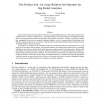Free Online Productivity Tools
i2Speak
i2Symbol
i2OCR
iTex2Img
iWeb2Print
iWeb2Shot
i2Type
iPdf2Split
iPdf2Merge
i2Bopomofo
i2Arabic
i2Style
i2Image
i2PDF
iLatex2Rtf
Sci2ools
CORR
2016
Springer
2016
Springer
Dot-Product Join: An Array-Relation Join Operator for Big Model Analytics
Big Data analytics has been approached exclusively from a data-parallel perspective, where data are partitioned to multiple workers – threads or separate servers – and model training is executed concurrently over different partitions, under various synchronization schemes that guarantee speedup and/or convergence. The dual – Big Model – problem that, surprisingly, has received no attention in database analytics, is how to manage models with millions if not billions of parameters that do not fit in memory. This distinction in model representation changes fundamentally how in-database analytics tasks are carried out. In this paper, we introduce the first secondary storage array-relation dot-product join operator between a set of sparse arrays and a dense relation targeted. The paramount challenge in designing such an operator is how to optimally schedule access to the dense relation based on the sparse non-contiguous entries in the sparse arrays. We prove that this problem is ...
| Added | 01 Apr 2016 |
| Updated | 01 Apr 2016 |
| Type | Journal |
| Year | 2016 |
| Where | CORR |
| Authors | Chengjie Qin, Florin Rusu |
Comments (0)

